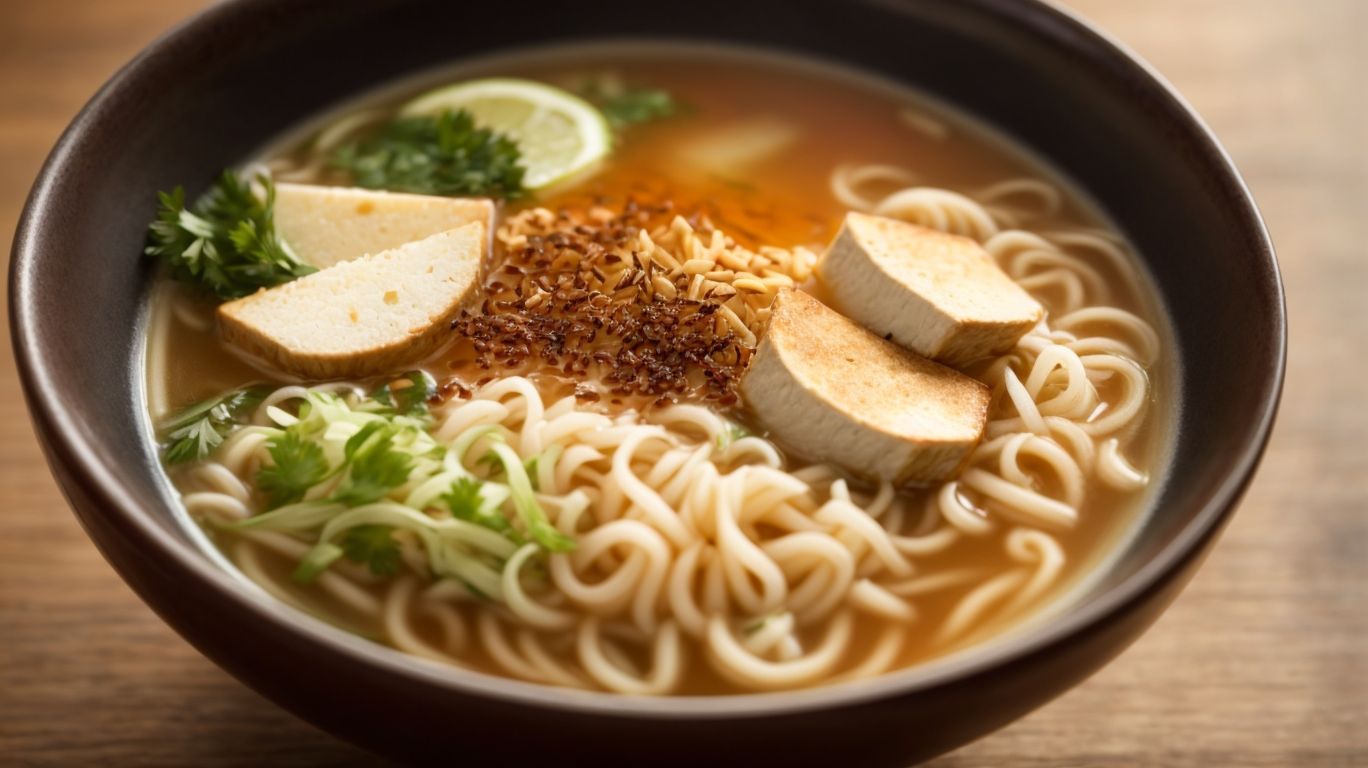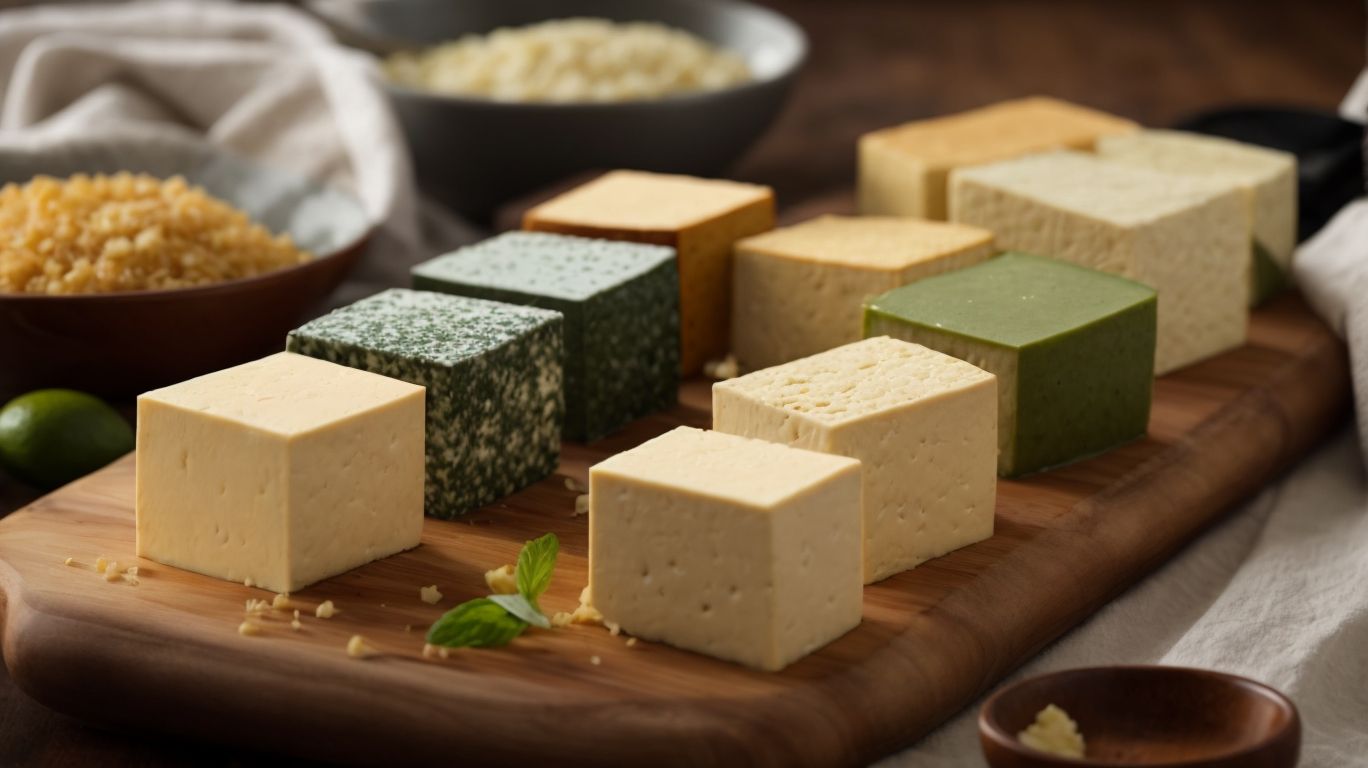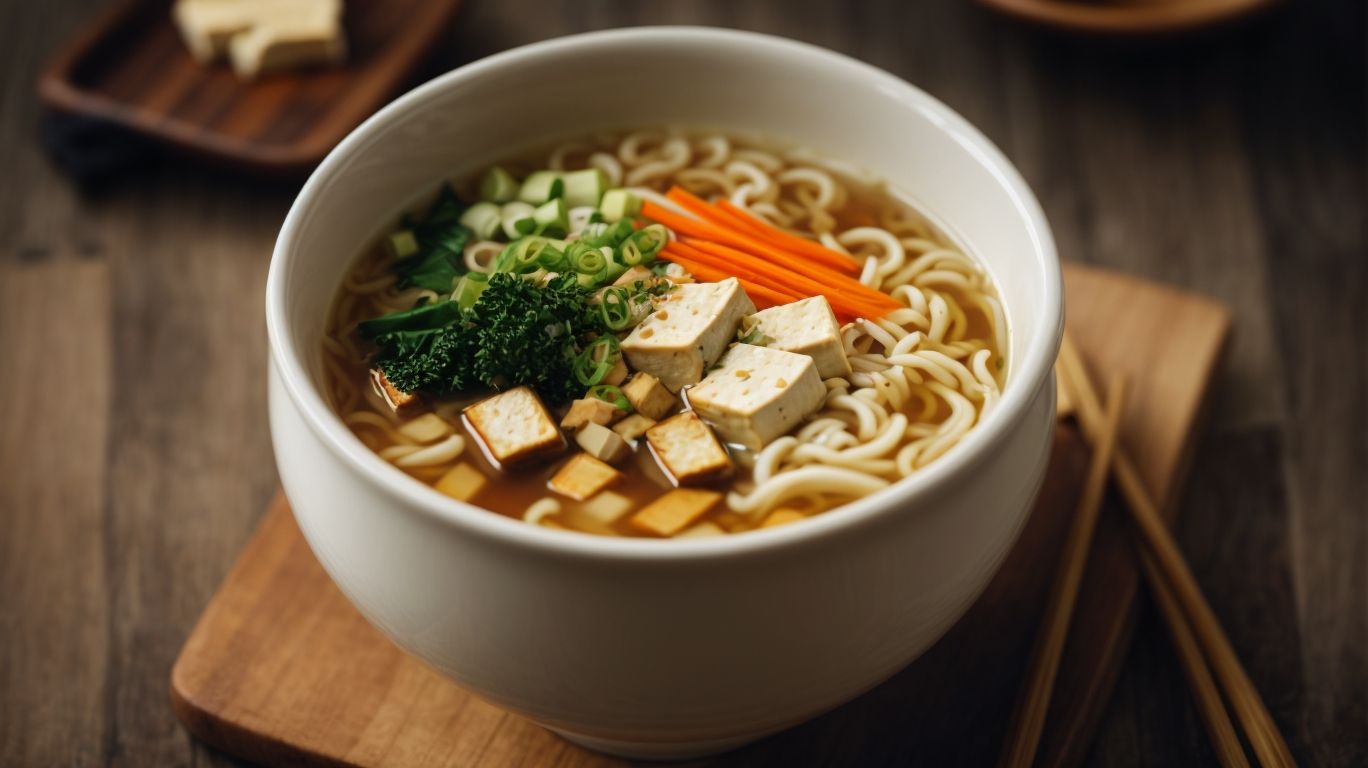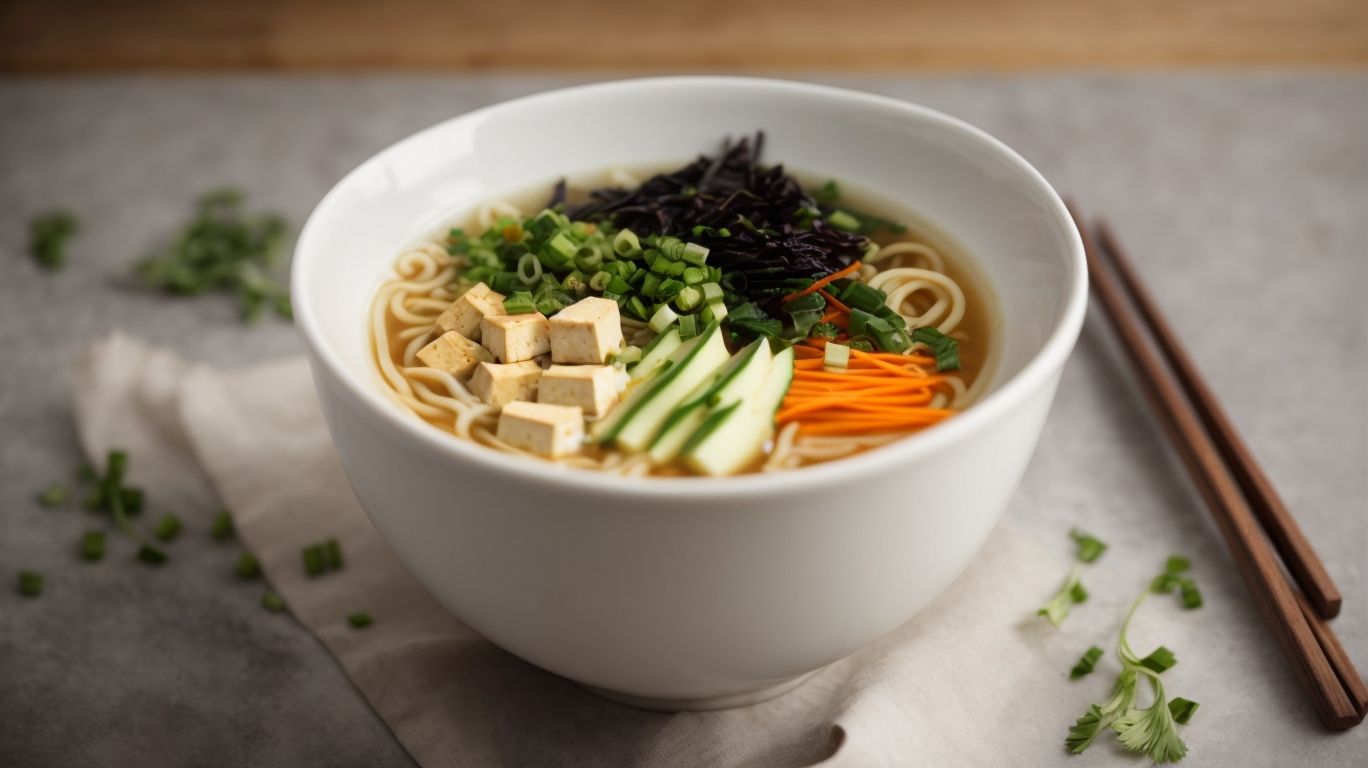How to Cook Tofu in Ramen?
.jpg)
Are you looking to elevate your ramen game?
Adding tofu to your bowl can not only enhance the flavor and texture but also provide essential nutritional benefits, especially for vegetarians and vegans.
In this article, we will explore the different types of tofu suitable for ramen, how to prepare tofu for cooking, various cooking methods, and helpful tips for a successful tofu ramen dish.
Let’s dive in and learn how to master the art of cooking tofu in ramen!
Key Takeaways:
1. Tofu is a nutritious addition to ramen, providing protein and enhancing flavor and texture.
2. The type of tofu used in ramen can affect the dish, with silken tofu being best for soup and firm or extra firm tofu for stir-fries.
3. Preparing and cooking tofu properly is key to achieving a delicious and satisfying ramen dish. Pressing, marinating, and pan-frying are all effective methods.
Why Add Tofu to Ramen?

Credits: Poormet.Com – Austin Perez
Adding tofu to ramen not only enhances the flavor and umami profile of the dish but also provides a nutritious and vegan-friendly option.
Tofu’s ability to absorb the savory broth in ramen allows it to infuse the dish with layers of flavor, creating a more complex and satisfying eating experience. This versatile ingredient can be prepared in various ways, from crispy fried tofu topping to soft and silky tofu cubes, adding different textures to each bite.
Tofu acts as a protein-packed addition, making the ramen a more substantial and fulfilling meal. Its neutral taste complements the other ingredients in the bowl, allowing the seasonings and broth to shine through while still offering a wholesome component to the dish.
Nutritional Benefits of Tofu
Tofu is a nutritional powerhouse, rich in plant-based protein and essential nutrients, making it a valuable addition to any diet.
With approximately 10 grams of protein per half-cup serving, tofu is an excellent source of plant-based protein for individuals looking to meet their daily protein requirements. Tofu contains important vitamins such as calcium, iron, and magnesium, essential for bone health and overall well-being.
For those following a vegan diet, tofu serves as a versatile and complete protein source, ensuring that they obtain all the essential amino acids necessary for optimal health. Tofu is low in saturated fat and cholesterol, making it a heart-healthy alternative to animal-derived proteins.
Incorporating tofu into your meals regularly can aid in weight management, as it is a satiating protein source that can help control hunger and prevent overeating. The isoflavones found in tofu have been linked to various health benefits, including reduced risk of heart disease, improved bone health, and potential protection against certain types of cancer.
Adds Protein to Vegetarian or Vegan Ramen
For those following a vegetarian or vegan diet, tofu serves as an excellent protein source in ramen dishes, ensuring a satisfying and nutritious meal.
Tofu, derived from soybeans, not only adds a substantial amount of protein to the broth but also enhances the overall texture and flavor of the dish. Its versatility allows it to absorb the savory flavors of the broth, making each spoonful delectably rich.
Protein plays a crucial role in the diets of vegetarians and vegans, as it aids in muscle repair, supports immune function, and helps maintain satiety. Tofu, often dubbed as a ‘complete’ protein, provides all essential amino acids, making it a valuable component in meeting daily nutritional requirements.
Enhances Flavor and Texture
The inclusion of tofu in ramen not only enriches the overall flavor profile but also adds a unique texture and umami richness to the dish.
When tofu is added to ramen, it absorbs the savory broth, infusing each bite with a creamy texture that contrasts beautifully with the chewy noodles and tender vegetables. The subtle sweetness of tofu perfectly complements the salty and savory notes of the broth, creating a harmonious balance of flavors. The umami elements in tofu elevate the taste profile of the entire dish, making each spoonful more flavorful and satisfying. Tofu’s ability to soak up the robust flavors of the broth and spices is what makes it an essential ingredient in creating a truly decadent ramen experience.
Types of Tofu for Ramen

Credits: Poormet.Com – Sean Williams
There are several varieties of tofu suitable for ramen, including silken tofu, firm tofu, and extra firm tofu, each offering distinct textures and applications in dishes.
Silken tofu, known for its smooth and custard-like texture, is perfect for adding creamy richness to ramen broths without altering the delicate flavors.
Firm tofu, with a slightly denser consistency, holds its shape well when stir-fried or grilled, providing a chewier bite to the ramen.
Extra firm tofu, on the other hand, is ideal for those who prefer a meatier texture in their ramen, as it retains its firmness even when simmered in the broth.
Silken Tofu
Silken tofu, with its soft and delicate texture, is ideal for adding a creamy element to ramen broths and soups, creating a luxurious mouthfeel.
Its velvety consistency effortlessly blends into the broth, infusing a subtle richness without overpowering other flavors. Whether it’s a traditional miso-based ramen or a spicy tantanmen, silken tofu complements the nuances of each broth, enhancing the overall dining experience.
Firm Tofu
Firm tofu, known for its versatility and absorbent nature, is a popular choice for adding texture and substance to ramen dishes, absorbing flavors effectively.
With its dense and compact structure, firm tofu has the ability to retain its shape and provide a satisfying bite in ramen bowls, making it a key ingredient in many vegetarian and vegan renditions.
Its neutral taste acts as a blank canvas, allowing it to take on the savory richness of broths and sauces, enhancing the overall complexity of the dish.
Unlike softer tofu varieties, firm tofu holds up well to heat and extended cooking times, ensuring that it remains intact and does not disintegrate when simmered in flavorful liquids.
Extra Firm Tofu
Extra firm tofu, with its crispy exterior and hearty texture, is an excellent option for adding a satisfying crunch to ramen bowls and stir-fry dishes.
Regarding preparing extra firm tofu for maximum crunchiness in ramen dishes, one popular technique is to press the tofu before cooking. By removing excess moisture, the tofu can achieve a firmer texture that crisps up beautifully when fried or baked.
Another method to enhance the crunch factor is marinating the tofu in a flavorful mixture before cooking, allowing it to absorb the seasonings and develop a tastier crust when cooked. This not only adds a delightful crunch but also infuses the tofu with delicious flavors that complement the rich broth of a ramen bowl.
How to Prepare Tofu for Ramen

Credits: Poormet.Com – Ronald Green
Properly preparing tofu for ramen involves essential steps such as pressing, marinating, and pan-frying to optimize its texture and flavor integration.
Pressing tofu is crucial as it helps to remove excess moisture, allowing it to absorb flavors better during the marinating process. Placing the tofu block between paper towels and applying pressure, like using a weighted object, for about 30 minutes can significantly enhance the tofu’s texture.
Regarding marinating, choose a mixture of soy sauce, sesame oil, garlic, and ginger for a traditional Asian flavor profile. Allow the tofu to sit in the marinade for at least 1 hour in the refrigerator to infuse the flavors deeply.
For pan-frying, ensure the pan is well-heated with a thin layer of oil to achieve a crispy exterior. Cook the tofu pieces until golden brown on each side, ensuring a crunchy and flavorful bite in your ramen dish.
Pressing Tofu
Pressing tofu is a crucial step in preparing it for ramen, as it helps expel excess moisture and ensures a firmer texture that can absorb flavors effectively.
Removing moisture from tofu is essential in achieving a chewier consistency that holds up well in soups like ramen. By pressing tofu, you not only improve its texture but also enable it to soak up the savory broth, enhancing the overall taste of the dish. Various methods can be used to press tofu, such as using a tofu press, stacking heavy objects on top, or wrapping it in a clean towel and placing a weight on it. These techniques aid in extracting water from the tofu, allowing for better flavor infusion and a more satisfying eating experience.
Marinating Tofu
Marinating tofu is a key technique to infuse it with flavors and seasonings that will complement the ingredients and broth in ramen dishes, enhancing the overall taste.
When marinating tofu for ramen, consider soaking it in a mixture of soy sauce, garlic, and ginger to build a savory base. Another method involves using a teriyaki marinade to add a sweet and umami kick to the tofu. Infusing the tofu with miso paste can also create a rich and complex flavor profile that pairs beautifully with ramen broths. The marination process helps the tofu absorb these delicious flavors, creating a perfect harmony with the rest of the dish.
Pan-frying Tofu
Pan-frying tofu to a crispy, golden brown finish adds a delightful texture and visual appeal to ramen bowls, providing a contrast to the broth and noodles.
To achieve such a perfect balance of crispy exterior and soft interior in the tofu, it is crucial to start with extra-firm tofu and press out excess moisture before cooking. This process helps the tofu absorb flavors more effectively and prevents sogginess during pan-frying.
When frying the tofu, make sure to use a well-heated pan with a generous amount of oil to facilitate even browning. Avoid overcrowding the pan, as this can lead to steaming rather than frying, resulting in a less crispy texture.
How to Cook Tofu in Ramen

Credits: Poormet.Com – Jacob Clark
Cooking tofu in ramen involves methods such as adding it to the broth, cooking it with noodles, and using it as a topping to create a harmonious and flavorful dish.
One popular way to incorporate tofu into ramen is to infuse it with flavorful broth by marinating the tofu in a mixture of soy sauce, ginger, garlic, and sesame oil before adding it to the simmering broth. This allows the tofu to soak up the delicious broth flavors, adding an extra layer of taste to your ramen. You can cook tofu alongside the noodles to ensure that it absorbs the broth’s essence while simmering together in the pot.
Add Tofu to Broth
Adding tofu to the broth while simmering allows it to absorb the rich flavors of the broth, enhancing its taste and contributing to a cohesive ramen experience.
Simmering the tofu in the broth is like a culinary magic trick; as the tofu softens slightly, it soaks up all the savory goodness from the simmering liquid, creating an explosion of flavor with every bite.
Through this process, the tofu becomes a flavor carrier, amplifying the essence of the broth and transforming into a delectable, broth-infused delight. The result is a bowl of ramen where every element harmonizes perfectly, bringing together the umami-laden broth and the velvety tofu for a truly satisfying culinary adventure.
Cook Tofu with Noodles
Cooking tofu with noodles in ramen involves boiling them together to ensure that the tofu retains its texture and complements the noodle consistency.
When cooking tofu and noodles in ramen, it’s crucial to select the right type of tofu that can stand up to boiling without disintegrating. Firm tofu works best for this purpose as it holds its shape during cooking.
Begin by bringing a pot of water to a gentle boil and then add in the tofu cubes followed by the noodles. To achieve a perfect balance, keep an eye on the cooking times – since tofu generally requires less time to cook than noodles, add the tofu first and wait until it starts to soften slightly before adding the noodles for a harmonious blend.
Top Ramen with Cooked Tofu
Using cooked tofu as a topping to garnish ramen bowls adds visual appeal and a contrasting texture, elevating the overall presentation and enjoyment of the dish.
When creatively presented on top of a steaming bowl of ramen, tofu transforms into a delightful addition that not only enhances the visual aesthetics of the dish but also provides a satisfying texture that complements the rich flavors of the broth. Experimenting with various tofu preparations, such as crispy fried tofu cubes or silky marinated slices, can offer a range of textures and flavors that harmonize with different types of ramen bases. By strategically placing slices or cubes of tofu alongside vibrant garnishes like fresh herbs, crunchy vegetables, or savory mushrooms, you can create a visually appealing composition that entices both the eyes and the taste buds.
Tips for Cooking Tofu in Ramen
Mastering the art of cooking tofu in ramen requires attention to key tips such as using high-quality tofu, experimenting with flavors, and adjusting cooking times for desired textures.
When selecting tofu for your ramen dish, opt for firm or extra-firm tofu as they hold their shape well during cooking and provide a satisfying texture. Marinating tofu in a mixture of soy sauce, garlic, and ginger before adding it to your ramen can elevate its taste profile. Consider pan-frying or baking the tofu before incorporating it into your broth to enhance its crispy exterior. Ensuring that the tofu is well-drained before using it in your ramen helps to prevent excess moisture and allows it to absorb more flavor from the broth.
Use High-Quality Tofu
Opting for high-quality tofu is essential when preparing ramen, as fresh and premium tofu enhances the overall taste and texture of the dish.
When selecting tofu for your ramen, keep an eye out for firmness and texture. High-quality tofu should have a firm and consistent texture, ensuring it holds up well when added to the hot broth without disintegrating. Another crucial factor to consider is the water content of the tofu. Lower water content indicates a denser tofu that will absorb flavors better, adding depth to your ramen.
Additionally, color and appearance can also be telling signs of quality. Look for tofu that has a uniform creamy white color without any off-putting discoloration. A fresh batch of tofu should have a slight sheen to it, indicating its freshness and moisture content, contributing to a more succulent ramen dish.
Experiment with Different Flavors
Exploring diverse flavor profiles and seasoning options for tofu in ramen opens up a world of culinary possibilities, allowing for creativity and personalization in every dish.
Regarding enhancing the flavors of tofu in ramen, the secret lies in experimenting with various herbs, spices, and seasonings. Whether it’s adding a smoky paprika kick for depth or a dash of umami-rich soy sauce for richness, the possibilities are endless. By deviating from traditional recipes and incorporating unique ingredients like lemongrass, sesame oil, or mirin, you can infuse your tofu dishes with a burst of new and exciting flavors.
Adjust Cooking Time for Desired Texture
Fine-tuning cooking times to achieve the desired texture in tofu is crucial for ensuring that it complements the overall dish and provides a satisfying culinary experience.
Regarding crafting the perfect tofu for your ramen, adjusting the cooking duration can make all the difference.
Whether you prefer a firm, chewy texture or a softer, melt-in-your-mouth consistency, the timing of cooking plays a crucial role.
A shorter cooking period will result in a more tender tofu, ideal for those who enjoy a delicate bite, while a longer cook time will yield a firmer texture that holds up well in the rich broth.
Conclusion

Credits: Poormet.Com – Jerry Young
The incorporation of tofu in ramen not only enhances the dish’s flavor and umami richness but also offers a versatile and satisfying cooking experience for culinary enthusiasts.
When tofu is added to ramen, it not only acts as a sponge, soaking up all the savory broth and seasoning, but also provides a textural contrast that delights the palate. The ability of tofu to absorb the surrounding flavors allows it to take on different taste profiles, adapting to a variety of seasoning styles, from traditional miso-based broths to spicy chili-infused soups.
The inclusion of tofu in ramen caters to diverse dietary needs, making it ideal for vegetarians, vegans, and individuals looking to incorporate more plant-based proteins in their meals.
Ultimately, the presence of tofu in ramen recipes elevates the overall satisfaction of the dish, offering a harmonious blend of flavors and textures that make every slurp a memorable experience.
Frequently Asked Questions
How to Cook Tofu in Ramen?
There are a few different ways to cook tofu in ramen, but my go-to method is to pan-fry it before adding it to the broth. This gives the tofu a crispy exterior and adds a nice texture to the dish.
Do I have to marinate the tofu before adding it to the ramen?
While marinating the tofu can add more flavor, it’s not necessary. If you’re short on time, you can simply season the tofu with salt and pepper before pan-frying or adding it to the broth.
Can I use any type of tofu for ramen?
Yes, you can use any type of tofu for ramen, but I personally prefer using firm or extra-firm tofu. These types of tofu hold their shape better and have a better texture for ramen.
How do I prevent the tofu from sticking to the pan?
To prevent the tofu from sticking to the pan, make sure your pan is well-greased and hot before adding the tofu. You can also use a non-stick pan or add a little oil or cooking spray to the pan before cooking.
Can I add the tofu directly to the ramen broth to cook?
Yes, you can add the tofu directly to the ramen broth to cook, but it may not have the same crispy texture as if you pan-fried it first. If you prefer a softer texture, this is a quick and easy option.
How long should I cook the tofu in the ramen broth?
If you choose to add the tofu directly to the broth, it should only take about 2-3 minutes to cook. If you pan-fry the tofu first, you can add it to the broth for about 1 minute just to warm it up before serving.



